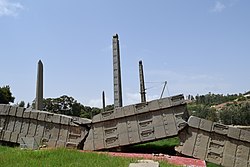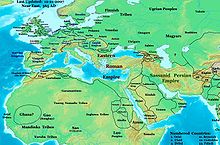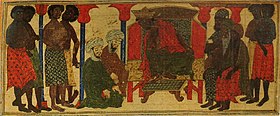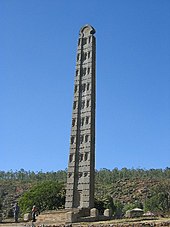Axum
Axum ኣኽሱም/አክሱም | |
|---|---|
City | |
 Northern Stelae Park | |
| Coordinates: 14°7′15″N 38°43′40″E / 14.12083°N 38.72778°ECoordinates: 14°7′15″N 38°43′40″E / 14.12083°N 38.72778°E | |
| Country | Ethiopia |
| Region | Tigray |
| Zone | Maekelay |
| Elevation | 2,131 m (6,991 ft) |
| Criteria | Cultural: i, iv |
| Reference | 15 |
| Inscription | 1980 (4th session) |
Axum or Aksum (/ˈæksuːm/; Tigrinya: ኣኽሱም Ak̠ʷsəm; Amharic: አክሱም Ak̠sum; Ancient Greek: Ἄξουμις[1] and Αὔξουμις[2]; Ethiopia is the site of the historic capital of the Aksumite Empire. It is now a tourist town[3][4][5] with a population of 66,800 residents (as of 2015).[6]
The Aksumite Empire was a naval and trading power that ruled the region from about 400 BCE into the 10th century. In 1980, UNESCO added Axum's archaeological sites to its list of World Heritage Sites due to their historic value.
Axum is located in the Maekelay Zone of the Tigray Region, near the base of the Adwa mountains. It has an elevation of 2,131 metres (6,991 ft) and is surrounded by La'ilay Maychew district.
History[edit]

Axum was the centre of the marine trading power known as the Aksumite Empire, which predated the earliest mentions in Roman-era writings. Around 356 CE, its ruler was converted to Christianity by Frumentius. Later, under the reign of the Emperor Kaleb, Axum was a quasi-ally of Byzantium against the Sasanian Empire which had adopted Zoroastrianism. The historical record is unclear, with ancient church records the primary contemporary sources.
It is believed it began a long and slow decline after the seventh century due partly to the Persians and then the Arabs contesting old Red Sea trade routes. Eventually Aksum was cut off from its principal markets in Alexandria, Byzantium and Southern Europe and its trade share was captured by Arab traders of the era. The Aksumite Empire was finally destroyed by Empress Gudit[citation needed], and eventually some of the people of Aksum were forced south and their old way of life declined. As the empire's power declined so did the influence of the city, which is believed to have lost population in the decline, similar to Rome and other cities thrust away from the flow of world events. The last known (nominal) emperor to reign was crowned in about the 10th century, but the empire's influence and power ended long before that.
Its decline in population and trade then contributed to the shift of the power center of the Ethiopian Empire south to the Agaw region as it moved further inland. The city of Axum was the administrative seat of an empire spanning one million square miles. Eventually, the alternative name (Ethiopia) was adopted by the central region, and subsequently, the present modern state.[7]
The Aksumite Empire and the Ethiopian Church[edit]


The Aksumite Empire had its own written language, Ge'ez, and developed a distinctive architecture exemplified by giant obelisks, the oldest of which (though much smaller) date from 5000–2000 BCE.[8] The empire was at its height under Emperor Ezana, baptized as Abreha, in the 4th century (which was also when it officially embraced Christianity).[9]
The Ethiopian Orthodox Tewahedo Church claims that the Church of Our Lady Mary of Zion in Axum houses the Biblical Ark of the Covenant, in which lie the Tablets of Stone upon which the Ten Commandments are inscribed.[10] Ethiopian traditions suggest that it was from Axum that Makeda, the Queen of Sheba, journeyed to visit King Solomon in Jerusalem and that the two had a son, Menelik, who grew up in Ethiopia but traveled to Jerusalem as a young man to visit his father's homeland. He lived several years in Jerusalem before returning to his country with the Ark of the Covenant. According to the Ethiopian Church and Ethiopian tradition, the Ark still exists in Axum. This same church was the site where Ethiopian emperors were crowned for centuries until the reign of Fasilides, then again beginning with Yohannes IV until the end of the empire. Axum is considered to be the holiest city in Ethiopia and is an important destination of pilgrimages.[10][11] Significant religious festivals are the Timkat festival (known as Epiphany in western Christianity) on 19 January (20 January in leap years) and the Festival of Maryam Zion on November 24.

In 1937, a 24-metre (79-foot) tall, 1,700-year-old Obelisk of Axum,was broken into five parts by the Italians and shipped to Rome to be erected. The obelisk is widely regarded as one of the finest examples of engineering from the height of the Axumite empire. Despite a 1947 United Nations agreement that the obelisk would be shipped back, Italy balked, resulting in a long-standing diplomatic dispute with the Ethiopian government, which views the obelisk as a symbol of national identity. In April 2005, Italy finally returned the obelisk pieces to Axum amidst much official and public rejoicing; Italy also covered the $4 million costs of the transfer. UNESCO assumed responsibility for the re-installation of this stele in Axum, and by the end of July 2008 the obelisk had been reinstalled (see panographic photos in external links below). It was unveiled on 4 September 2008.[12][13]
Axum and Islam[edit]
The Aksumite Empire had a longstanding relationship with Islam. According to ibn Hisham,[14] when Muhammad faced oppression from the Quraysh clan, he sent a small group that included his daughter Ruqayya and her husband Uthman to Axum. Sahama, the Aksumite monarch,[15] gave them refuge and protection. He refused the requests of the Quraish clan to send these refugees back to Arabia. These refugees did not return until the sixth Hijri year (628), and even then many remained in Ethiopia, eventually settling at Negash in what is now the Mibraqawi Zone.[citation needed]
There are different traditions concerning the effect these early Muslims had on the ruler of Axum. The Muslim tradition is that the ruler of Axum was so impressed by these refugees that he became a secret convert.[16] On the other hand, Arabic historians and Ethiopian tradition state that some of the Muslim refugees who lived in Ethiopia during this time converted to Orthodox Christianity. There is also a second Ethiopian tradition that, on the death of Ashama ibn Abjar, Muhammed is reported to have prayed for the king's soul, and told his followers, "Leave the Abyssinians in peace, as long as they do not take the offensive."[17]
Main sights[edit]

The major Aksumite monuments in the town are steles. These obelisks are around 1,700 years old and have become a symbol of the Ethiopian people's identity.[18] The largest number are in the Northern Stelae Park, ranging up to the 33-metre-long (3.84 metres wide, 2.35 metres deep, weighing 520 tonnes) Great Stele, believed to have fallen and broken during construction.[19] The Obelisk of Axum (24.6 metres high, 2.32 metres wide, 1.36 metres deep, weighing 170 tonnes) was removed by the Italian army in 1937, and returned to Ethiopia in 2005 and reinstalled July 31, 2008.[18] The next tallest is the 24-metre (20.6 metres high above the front baseplate, 2.65 metres wide, 1.18 metres deep, weighing 160 tonnes) King Ezana's Stela. Three more stelae measure 18.2 metres high, 1.56 metres wide, 0.76 metres deep, weighing 56 tonnes; 15.8 metres high, 2.35 metres wide, one metre deep, weighing 75 tonnes; 15.3 metres high, 1.47 metres wide, 0.78 metres deep, weighing 43 tonnes.[20] The stelae are believed to mark graves and would have had cast metal discs affixed to their sides, which are also carved with architectural designs. The Gudit Stelae to the west of town, unlike the northern area, are interspersed with mostly 4th century tombs.
The other major feature of the town are the old and new Church of Our Lady Mary of Zion. The Church of Our Lady Mary of Zion was built in 1665 by Emperor Fasilides and said to have previously housed the Ark of the Covenant. The original cathedral, said to have been built by Ezana and augmented several times after was believed to have been massive with 12 naves. It was burned to the ground by Gudit, rebuilt, and then destroyed again during the Abyssinian–Adal war of the 1500s. It was again rebuilt by Emperor Gelawdewos (completed by his brother and successor Emperor Minas) and Emperor Fasilides replaced that structure with the present one. Only men are permitted entry into the Old St. Mary's Cathedral (some say as a result of the destruction of the original church by Gudit). The New Cathedral of St. Mary of Zion stands next to the old one, and was built to fulfill a pledge by Emperor Haile Selassie to Our Lady of Zion for the liberation of Ethiopia from the Fascist occupation. Built in a neo-Byzantine style, work on the new cathedral began in 1955, and allows admittance to women. Emperor Haile Selassie interrupted the state visit of Britain's Queen Elizabeth II to travel to Axum to attend the dedication of the new Cathedral and pay personal homage, showing the importance of this church in the Ethiopian Empire. The Queen visited the Cathedral a few days later. Between the two cathedrals is a small chapel known as The Chapel of the Tablet built at the same time as the new cathedral, and which is believed to house the Ark of the Covenant. Emperor Haile Selassie's consort, Empress Menen Asfaw, paid for its construction from her private funds. Admittance to the chapel is closed to all but the guardian monk who resides there. Entrance is even forbidden to the Patriarch of the Orthodox Church, and to the Emperor of Ethiopia during the monarchy. The two cathedrals and the chapel of the Ark are the focus of pilgrimage and considered the holiest sites in Ethiopia to members of its Orthodox Church.
Other attractions in Axum include archaeological and ethnographic museums, the Ezana Stone written in Sabaean, Ge'ez and Ancient Greek in a similar manner to the Rosetta Stone, King Bazen's Tomb (a megalith considered to be one of the earliest structures), the so-called Queen of Sheba's Bath (actually a reservoir), the 4th-century Ta'akha Maryam and 6th-century Dungur palaces, Pentalewon Monastery and Abba Liqanos and the Lioness of Gobedra rock art
Local legend claims the Queen of Sheba lived in the town.
Earlier Researches[edit]
In February 1893, the British explorers Theodore Bent and Mabel Bent travelled by boat to Massawa on the Red Sea west coast and made their way overland to excavate at Aksum and Yeha, in the hope of researching possible links between early trading networks and cultures on both sides of the Red Sea.[21] They reached Aksum by 24 February 1893,[22] but their work was curtailed[23]by the tensions between the Italian occupiers and local warlords, continuing ramifications of the First Italo-Ethiopian War, and they had to make a hasty retreat by the end of March to Zula for passage back to England.[24]
Climate[edit]
Köppen-Geiger climate classification system classifies its climate as subtropical highland (Cwb).[25]
| Climate data for Axum | |||||||||||||
|---|---|---|---|---|---|---|---|---|---|---|---|---|---|
| Month | Jan | Feb | Mar | Apr | May | Jun | Jul | Aug | Sep | Oct | Nov | Dec | Year |
| Average high °C (°F) | 25.9 (78.6) |
27.2 (81.0) |
28.6 (83.5) |
29.4 (84.9) |
28.8 (83.8) |
27.0 (80.6) |
22.5 (72.5) |
22.3 (72.1) |
24.8 (76.6) |
26.3 (79.3) |
26.8 (80.2) |
25.7 (78.3) |
26.3 (79.3) |
| Daily mean °C (°F) | 16.7 (62.1) |
17.8 (64.0) |
17.7 (63.9) |
21.0 (69.8) |
20.8 (69.4) |
19.7 (67.5) |
17.2 (63.0) |
17.4 (63.3) |
17.9 (64.2) |
17.9 (64.2) |
17.4 (63.3) |
16.2 (61.2) |
18.1 (64.7) |
| Average low °C (°F) | 7.5 (45.5) |
8.4 (47.1) |
10.8 (51.4) |
12.7 (54.9) |
12.9 (55.2) |
12.4 (54.3) |
12.0 (53.6) |
12.6 (54.7) |
11.1 (52.0) |
9.6 (49.3) |
8.0 (46.4) |
6.7 (44.1) |
10.4 (50.7) |
| Average precipitation mm (inches) | 3 (0.1) |
2 (0.1) |
9 (0.4) |
27 (1.1) |
31 (1.2) |
67 (2.6) |
221 (8.7) |
199 (7.8) |
67 (2.6) |
12 (0.5) |
13 (0.5) |
1 (0.0) |
652 (25.6) |
| Source: Climate-Data.org (altitude: 2133m)[25] | |||||||||||||
Demographics[edit]
According to Central Statistical Agency of Ethiopia (CSA), as of July 2012 (est.) the town of Axum's population was 56,576. The census indicated that 30,293 of the population were females and 26,283 were males.[26] The 2007 national census showed that the town population was 44,647, of whom 20,741 were males and 23,906 females). The majority of the inhabitants said they practised Ethiopian Orthodox Christianity, with 88.03% reporting that as their religion, while 10.89% of the population were Muslim.[27]
The 1994 national census reported a total population for this city of 27,148, of whom 12,536 were men and 14,612 were women. The largest ethnic group reported was the Tigrayan (98.54%) and Tigrinya was spoken as a first language by 98.68%. The majority of the population practised Ethiopian Orthodox Christianity with 85.08% reported as embracing that religion, while 14.81% were Muslim.[28]
Transportation[edit]

Air transportation in Axum is served by the Axum Airport.
Education[edit]
The Axum University was established in Axum in May 2006 on a greenfield site, four kilometers (2.45 miles) from the town center; the inauguration ceremony was held on 16 February 2007. The current area of the campus is 107 hectares, with ample room for expansion.[citation needed] The establishment of a university in Axum is expected to contribute much to the ongoing development of the country in general and of the region in particular.
3D Documentation with Laser-Scanning[edit]
The Zamani Project, document cultural heritage sites in 3D to create a record for future generations.[29][30][31][32] The documentation is based on terrestrial laser-scanning.[33][34] The 3D documentation of parts of the Axum Stelae Field was carried out in 2006.[35] 3D models, plans and images can be view here.
Gallery[edit]
See also[edit]
References[edit]
- ^ Stephanus of Byzantium, Ethnica, §A102.8
- ^ Photius, Bibliotheca excerpts, §3.1
- ^ Centre, UNESCO World Heritage. "Aksum". UNESCO World Heritage Centre. UNESCO. Retrieved 24 February 2019.
- ^ "Aksum Ethiopia". Encyclopedia Britannica. Retrieved 24 February 2019.
- ^ Phillipson, David W. (2014). Foundations of an African Civilisation: Aksum and the Northern Horn, 1000 BC - AD 1300. Boydell & Brewer Ltd. p. 69. ISBN 9781847010889. Retrieved 24 February 2019.
At Aksum itself, little is known about the earliest phases, such as might aid our understanding of the transition. Archaeological investigation has been restricted by the presence of the modern town, and penetration of the lowest levels is impeded by later features which merit preservation.
- ^ "City Population".
- ^ G. Mokhtar, UNESCO General History of Africa, Vol. II, Abridged Edition (Berkeley: University of Aksum Press, 1990), pp. 215-35. ISBN 0-85255-092-8
- ^ Uhlig, Siegbert, ed. Encyclopaedia Aethiopica: D-Ha (Wiesbaden: Harrassowitz Verlag, 2005), p. 871.
- ^ Fage, J. D., A History of Africa (London: Routledge, 2001), pp. 53–4. ISBN 0-415-25248-2
- ^ a b Hodd, Mike, Footprint East Africa Handbook (New York: Footprint Travel Guides, 2002), p. 859. ISBN 1-900949-65-2.
- ^ See Linda Kay Davidson and David Gitlitz Pilgrimage, from the Ganges to Graceland: an Encyclopedia (Santa Barbara: ABC-CLIO, 2002), 17–18.
- ^ "Ethiopia unveils ancient obelisk". BBC News. 4 September 2008. Retrieved 22 February 2014.
- ^ "The Reinstallation of the Axum Obelisk" (PDF). UNESCO. 10 October 2008. Retrieved 22 February 2014.
- ^ ibn Hisham, The Life of the Prophet
- ^ Nimer, Ph.D., Muḥammad. "Exegesis, Social Science and the Place of the Jews in the Qur'an". Archived from the original on 31 July 2013. Retrieved 23 January 2013.
- ^ Ibn Ishaq, The Life of Muhammad (Oxford, 1955), 657–58.
- ^ Paul B. Henze, Layers of Time: A History of Ethiopia (New York: Palgrave, 2000), pp. 42f
- ^ a b "Mission accomplished: Aksum Obelisk successfully reinstalled". UNESCO. 1 August 2008. Retrieved 23 January 2013.
- ^ Phillipson, David W. (2003). "Aksum: An archaeological introduction and guide". Azania: Archaeological Research in Africa. 38 (1): 1–68. doi:10.1080/00672700309480357.
- ^ Scarre, Chris Seventy Wonders of the Ancient World 1999
- ^ Bent published the trip in his: The sacred city of the Ethiopians: being a record of travel and research in Abyssinia in 1893, London, Longmans, Green and Co, 1894.
- ^ The Travel Chronicles of Mrs J. Theodore Bent, Vol. 2, 2012, Oxford, Archaeopress, page 201.
- ^ ‘Theodore Bent’s expedition to Abyssinia for the purpose of investigating the ruins of Aksum has not been so successful as might have been wished, owing to the hostilities which are being carried on between two of the chiefs; indeed, he and Mrs. Bent had a narrow escape from being involved in their hostilities. Still the expedition has not been altogether without interesting results.’ (Mountstuart E. Grant Duff, The Annual Address on the Progress of Geography, 1892-93, The Geographical Journal, Vol. 2, No. 1 (Jul., 1893), 21).
- ^ Bent published three further accounts relating to their Ethiopian trip of 1893: From the Heart of Abyssinia, Illustrated London News, 8 April 1893; In the North of Abyssinia, Illustrated London News, 6 May 1893; The Ancient Trade Route across Ethiopia, The Geographical Journal, Vol. 2 (2) (Aug), 140-6.
- ^ a b "Climate: Aksum - Climate graph, Temperature graph, Climate table". Climate-Data.org. Retrieved 2013-12-09.
- ^ "National Statistics-population-2011 by town and sex". Archived from the original on 26 January 2013. Retrieved 23 January 2013.
- ^ Census 2007 Tables: Tigray Region Archived November 14, 2010, at the Wayback Machine, Tables 2.1, 2.4, 2.5 and 3.4.
- ^ 1994 Population and Housing Census of Ethiopia: Results for Southern Nations, Nationalities and Peoples' Region, Vol. 1, part 1 Archived November 19, 2008, at the Wayback Machine, Tables 2.2, 2.13, 2.16, 2.20 (accessed 30 December 2008)
- ^ Rüther, Heinz; Rajan, Rahim S. (2007). "Documenting African Sites: The Aluka Project". Journal of the Society of Architectural Historians. 66 (4): 437–443. doi:10.1525/jsah.2007.66.4.437. ISSN 0037-9808. JSTOR 10.1525/jsah.2007.66.4.437.
- ^ Rüther, Heinz. "AN AFRICAN HERITAGE DATABASE – THE VIRTUAL PRESERVATION OF AFRICA'S PAST" (PDF). isprs.org.
- ^ Giles, Chris. "Meet the scientists immortalizing African heritage in virtual reality". CNN. Retrieved 2019-10-17.
- ^ Wild, Sarah. "Africa's great heritage sites are being mapped out with point precision lasers". Quartz Africa. Retrieved 2019-10-17.
- ^ Rüther, Heinz; Held, Christof; Bhurtha, Roshan; Schroeder, Ralph; Wessels, Stephen (2012-01-13). "From Point Cloud to Textured Model, the Zamani Laser Scanning Pipeline in Heritage Documentation". South African Journal of Geomatics. 1 (1): 44–59–59. ISSN 2225-8531.
- ^ "Challenges in Heritage Documentation with Terrestrial Laser Scanning" (PDF).
- ^ "Site - Aksum Obelisk". zamaniproject.org. Retrieved 2019-10-18.
Further reading[edit]
- Francis Anfray. Les anciens ethiopiens. Paris: Armand Colin, 1991.
- Yuri M. Kobishchanov. Axum (Joseph W. Michels, editor; Lorraine T. Kapitanoff, translator). University Park, Pennsylvania: University of Pennsylvania, 1979. ISBN 0-271-00531-9
- David W. Phillipson. Ancient Ethiopia. Aksum: Its antecedents and successors. London: The British Brisith Museum, 1998.
- David W. Phillipson. Archaeology at Aksum, Ethiopia, 1993–7. London: British Institute in Eastern Africa, 2000. ISBN 1-872566-13-8
- Stuart Munro-Hay. Aksum: An African Civilization of Late Antiquity. Edinburgh: University Press. 1991. ISBN 0-7486-0106-6 online edition
- Stuart Munro-Hay. Excavations at Aksum: An account of research at the ancient Ethiopian capital directed in 1972-74 by the late Dr Nevill Chittick London: British Institute in Eastern Africa, 1989 ISBN 0-500-97008-4
- Sergew Hable Sellassie. Ancient and Medieval Ethiopian History to 1270 Addis Ababa: United Printers, 1972.
- African Zion, the Sacred Art of Ethiopia. New Haven: Yale University Press, 1993.
- J. Theodore Bent. The Sacred City of the Ethiopians: Being a Record of Travel and Research in Abyssinia in 1893. London: Longmans, Green and Co, 1894. online edition
External links[edit]
| Wikivoyage has a travel guide for Axum. |
| Wikimedia Commons has media related to Aksum. |
| Wikisource has the text of the 1911 Encyclopædia Britannica article Axum. |
- Ethiopian Treasures — Queen of Sheba, Aksumite Kingdom — Aksum
- Kingdom of Aksum article from "About Archaeology"
- UNESCO – World Heritage Sites — Aksum
- The Metropolitan Museum of Art — "Foundations of Aksumite Civilization and Its Christian Legacy (1st–7th century)"
- On Axum
- More on Axum
- Axum from Catholic Encyclopedia
- Final obelisk section in Ethiopia, BBC, 25 April 2005
- Axum Heritage Site on Aluka digital library
- Aksum World Heritage Site in panographies – 360 degree interactive imaging




















